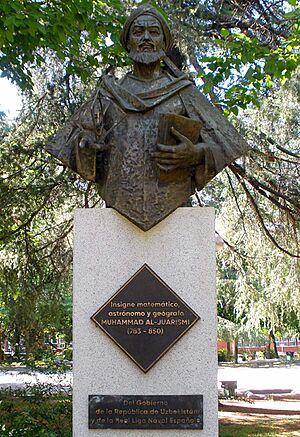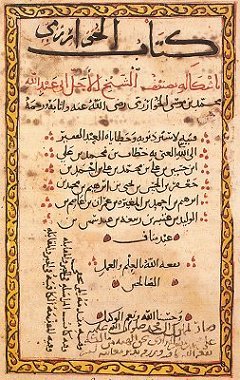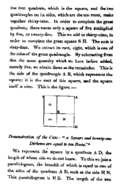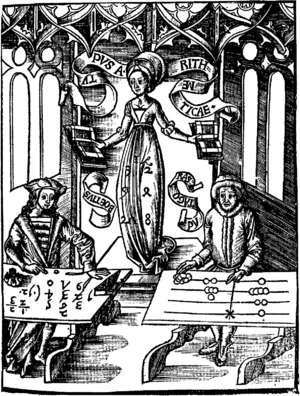Muhammad ibn Musa al-Khwarizmi facts for kids
Quick facts for kids
Muḥammad ibn Mūsā al-Khwārizmī
|
|
|---|---|
| محمد بن موسى الخوارزمي | |
| Born | c. 780 |
| Died | After 847 (aged c. 70) |
| Era | Islamic Golden Age (Abbasid era) |
| Scientific career | |
| Influenced | Abu Kamil |
Muḥammad ibn Mūsā al-Khwārizmī (Arabic: محمد بن موسى الخوارزمي; born around 780 CE, died after 847 CE), often called al-Khwarizmi, was a brilliant Persian scholar. He was a true polymath, meaning he was an expert in many different subjects. He made huge contributions to mathematics, astronomy, and geography.
Around 820 CE, al-Khwarizmi worked in Baghdad at the House of Wisdom. This was a famous center for learning during the Islamic Golden Age. He was an astronomer and even the head of the library there.
Al-Khwarizmi's most famous work was a book on algebra. It was called The Compendious Book on Calculation by Completion and Balancing. This book showed the first clear ways to solve different types of equations. He is often called the "father of algebra" because he helped make it a separate field of study. The word "algebra" actually comes from the Arabic title of his book, al-jabr.
His name also gave us the words algorism and algorithm. An algorithm is a step-by-step process for solving a problem, especially in math or computer science.
In the 12th century, his books were translated into Latin. These translations helped introduce the Hindu–Arabic numeral system (the numbers we use today, like 1, 2, 3) to the Western world. His algebra book was used in European universities for hundreds of years.
Besides math, al-Khwarizmi also improved Ptolemy's Geography by listing the exact locations of many cities. He also created detailed astronomical tables and wrote about calendars, astrolabes, and sundials. He even made important advances in trigonometry, creating tables for sine, cosine, and tangent.
Contents
Life
We don't know many exact details about al-Khwarizmi's life. He was born in Khwarazm, a region that is now part of Turkmenistan and Uzbekistan. His name, "al-Khwarizmi," means "the native of Khwarazm."
He did most of his important work between 813 and 833 CE. During this time, Baghdad was a major center for science and trade. He worked at the House of Wisdom, which was a large library and research center. There, he studied science and mathematics. He also helped translate important scientific books from Greek and Sanskrit.
Some historians believe he might have been involved in a trip to the Khazars, a group of people living in Eastern Europe.
Contributions
Al-Khwarizmi's work in mathematics, geography, astronomy, and cartography (map-making) laid the groundwork for many new ideas. His systematic way of solving equations led to the field of algebra.
His book On the Calculation with Hindu Numerals was very important. It helped spread the Hindu–Arabic numeral system (our numbers 0-9) across the Middle East and Europe. When this book was translated into Latin, al-Khwarizmi's name, Algoritmi, became the source of the word "algorithm."
Some of his ideas were based on older knowledge from Persia, Babylonia, India, and Greece.
Al-Khwarizmi also improved the maps and information from Ptolemy, an ancient Greek scholar. He created a book called Kitab surat al-ard ("The Image of the Earth"). This book listed the exact locations of places, making maps more accurate.
He also wrote about tools like the astrolabe and sundial. He even helped with a project to measure the size of the Earth and create a world map for the Caliph al-Ma'mun. His works, when translated into Latin, had a huge impact on how mathematics developed in Europe.
Algebra
Al-Khwarizmi's most famous book is The Compendious Book on Calculation by Completion and Balancing. He wrote it around 820 CE. This book was meant to be a helpful guide for everyday calculations. It included examples for problems in trade, land surveying, and legal inheritance.
The word "algebra" comes from "al-jabr," one of the main operations described in this book. Al-jabr means "restoration" or "completion." It refers to adding a number to both sides of an equation to make it simpler. For example, if you have x2 = 40x − 4x2, you add 4x2 to both sides to get 5x2 = 40x.
The book also used "al-muqabala," which means "balancing." This is about moving terms of the same type to the same side of an equation. For example, if you have x2 + 14 = x + 5, you can balance it to x2 + 9 = x.
Al-Khwarizmi's book showed how to solve different types of equations. He explained these problems using words, because the mathematical symbols we use today hadn't been invented yet.
Historians note that al-Khwarizmi's algebra was different from what Indian mathematicians were doing. He introduced specific rules like "restoration" and "reduction" that were new.
Arithmetic
Al-Khwarizmi's second most important work was about arithmetic. The original Arabic version is lost, but we have Latin translations. His writings described how to do calculations using decimal numbers (our modern number system).
These calculations were often done on a "dust board" (called takht in Arabic). This was a board covered with a thin layer of dust or sand. People could write numbers on it with a stylus and easily erase them. Al-Khwarizmi's methods were used for almost 300 years.
When these texts reached Europe in the 12th century, they changed how people did math. Al-Khwarizmi's Latinized name, Algorismus, became the name for this new way of computing. This is where our modern word "algorithm" comes from. His methods slowly replaced the older ways of calculating using an abacus.
One important Latin translation is called Dixit Algorizmi ("Thus spake Al-Khwarizmi"). This book helped introduce the Hindu–Arabic numeral system to the Western world.
Astronomy
Al-Khwarizmi's Zīj al-Sindhind was a collection of astronomical tables. It had about 37 chapters on how to calculate dates and astronomical events. It also included 116 tables with data about calendars, stars, planets, and even a table of sine values.
This work was based on Indian astronomical methods. It included tables for the movements of the sun, the moon, and the five planets known at that time. This book was a turning point for Islamic astronomy. Before this, Muslim astronomers mostly translated and learned from others' works. Al-Khwarizmi's book started a new era of original research.
The original Arabic version of this book is lost. However, a Latin translation from around 1126 CE still exists.
Trigonometry
Al-Khwarizmi's astronomical tables also included tables for trigonometric functions like sines and cosines. He also created the first table of tangents. These tables were very accurate and important for later developments in mathematics and astronomy.
Geography

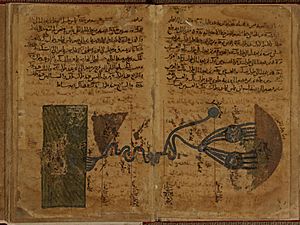

Al-Khwarizmi's third major work was his Kitāb Ṣūrat al-Arḍ ("Book of the Description of the Earth"). He finished it in 833 CE. This book was a big improvement on Ptolemy's Geography from the second century. It listed the exact latitudes and longitudes of 2402 cities and other places.
Only one copy of the Arabic version of this book still exists. A Latin translation is also available. The book starts with lists of latitudes and longitudes, organized by "weather zones." This system made it easier to figure out locations even if parts of the document were hard to read.
Neither the Arabic copy nor the Latin translation includes the actual map. However, a scholar named Hubert Daunicht was able to recreate the map using the list of coordinates. He plotted the points and connected them to show what the original map looked like.
Al-Khwarizmi corrected a big mistake Ptolemy made about the length of the Mediterranean Sea. Ptolemy thought it was much longer than it is. Al-Khwarizmi's estimate was much closer to the real length. He also showed the Atlantic Ocean and Indian Ocean as open bodies of water, not landlocked seas as Ptolemy had done.
Jewish calendar
Al-Khwarizmi also wrote about the Hebrew calendar. His book, Risāla fi istikhrāj ta'rīkh al-yahūd ("Extraction of the Jewish Era"), explained how the calendar works. It described the 19-year cycle used in the calendar and rules for determining important dates.
Other works
Al-Khwarizmi wrote several other books. One was a book of historical records called Kitāb al-Taʾrīkh. No full copy of this book survives today.
He also wrote about sundials and how to determine the direction of Mecca. He wrote two books about how to use and build astrolabes, which were important tools for astronomers and navigators.
Honors
- Al-Khwarizmi (crater) — A crater on the far side of the moon is named after him.
- 13498 Al Chwarizmi — A main-belt asteroid is named after him.
- 11156 Al-Khwarismi — Another main-belt asteroid is named after him.
Images for kids
See also
 In Spanish: Al-Juarismi para niños
In Spanish: Al-Juarismi para niños


